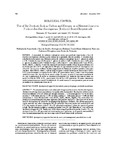Please use this identifier to cite or link to this item:
http://www.alice.cnptia.embrapa.br/alice/handle/doc/491648| Title: | Use of by-products rich in carbon and nitrogen as a nutrient source to produce Bacillus thuringiensis (Berliner) -based biopesticide. |
| Authors: | VALICENTE, F. H.  MOURÃO, A. H. C.   |
| Affiliation: | FERNANDO HERCOS VALICENTE, CNPMS; André H.C. Mourão, Estudante do Curso de Meio Ambiente. |
| Date Issued: | 2008 |
| Citation: | Neotropical Entomology, Londrina, v. 37, n. 6, p. 702-708, 2008. |
| Description: | The amount and sources of carbon and nitrogen used to produce Bacillus thuringiensis(Berliner)-based biopesticide may in fluence the quality of the final product. The objective of this research was to test different levels of carbon and nitrogen: medium 1 - 1.5% maize glucose + 0.5% soy flour, medium 2 - 3.0% maize glucose + 1.0% soy flour, medium 3 - 1.0% maize glucose + 3.0% soy flour and medium 4 - Luria Bertani (LB) + salts (FeSO4, ZnSO4, MnSO4, MgSO4). The seed culture was produced in LB medium plus salt, under agitation (200 rpm) for 18h at 30oC. The strain 344 of Bt was used (B. thuringiensis var tolworthi ? belonging to the Embrapa ?s Bt Bank). The pH was measured at regular intervals. and After culturing for 96h, the pH of the four tested media was basified (6.91 and 8.15), the number of spores yielded 4.39 x 109 spores/ml in medium 3, where the amount of protein is high. The dry biomass weight accumulated in media 3 was 39.3 g/l. Mortality of 2-day-old larvae Spodoptera frugiperda (J.E. Smith) was 100% when using Bt produced in media 3 and 4. CL50 for medium 3 was 8.4 x 106 spores/ml. All tested media were satisfactory to Bt growth, and medium 3 wass the most promising to be used on a large scale Bt-based biopesticide production. A quantidade de carbono e nitrogênio usados para produzir biopesticidas à base de Bacillus thuringiensis (Berliner) pode influenciar a qualidade final do produto. O objetivo deste trabalho foi testar meios com diferentes níveis de carbono e nitrogênio: meio 1 - glicose de milho a 1.5% + farinha de soja a 0,5%, meio 2 - glicose de milho a 3,0% + farinha de soja a 1,0%, meio 3 - glicose de milho a 1,0% + farinha de soja a 3,0% e meio 4 - Luria Bertani (LB) + sais (FeSO4, ZnSO4, MnSO4 e MgSO4). O inóculo semente foi produzido usando 150 ml de meio LB mais sais incubados por 18h a 30oC, sob agitação de 200 rpm. A cepa utilizada foi 344 (B. thuringiensis var tolworthi ? pertencente ao Banco de Microorganismos da Embrapa). O pH foi medido a intervalos regulares. Após 96h de cultivo, o pH de todos os meios testados tenderam ao básico (entre 6,91 e 8,15), o maior número de esporos foi de 4,39 x 109 sporos/ml no meio 3, onde o teor de proteína usado foi o mais alto. A produção de massa celular foi maior no meio 3, com total acumulado de 39,3 g/l. A mortalidade de larvas de Spodoptera frugiperda (J.E. Smith) de dois dias de idade nos meios 3 e 4 foi de 100%. A CL50 para o meio 3 foi de 8,4 x 106 esporos/ml. Os meios alternativos usados promoveram crescimento satisfatório de Bt, sendo o meio 3 o mais promissor para ser usado na produção de biopesticida à base de Bt. |
| Thesagro: | Spodoptera Frugiperda |
| Keywords: | Biocontrol Insect pest management Microbial insecticide |
| DOI: | 10.1111/j.1439-0418.2007.01264 |
| Type of Material: | Artigo de periódico |
| Access: | openAccess |
| Appears in Collections: | Artigo em periódico indexado (CNPMS)  |
Files in This Item:
| File | Description | Size | Format | |
|---|---|---|---|---|
| Useproducts.pdf | 267,3 kB | Adobe PDF |  View/Open |









